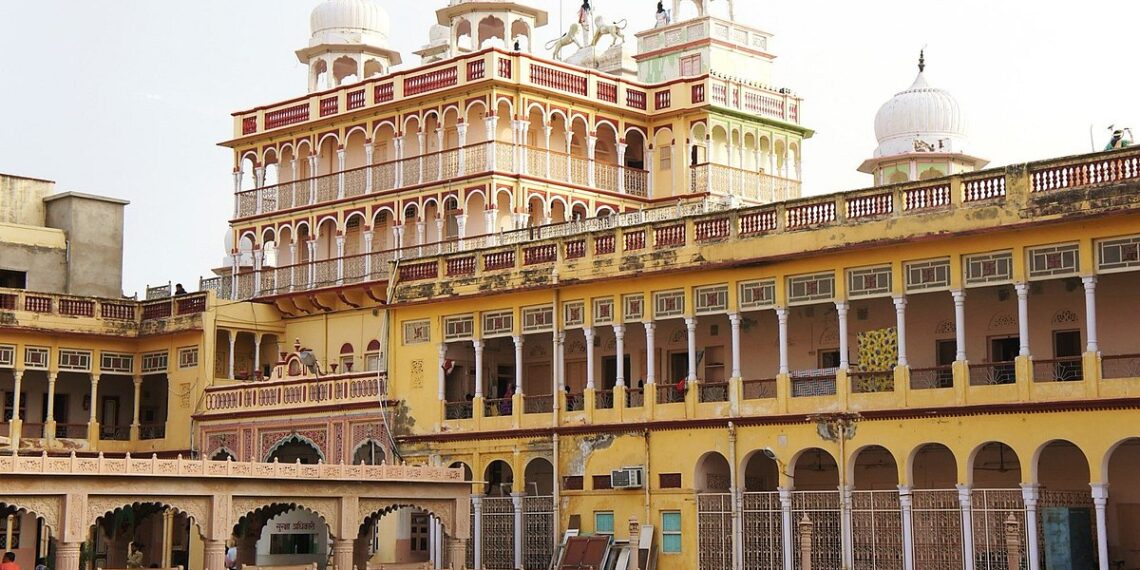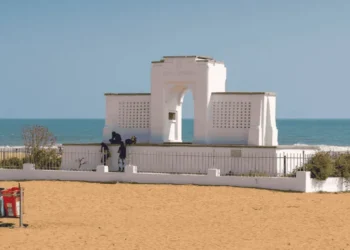Rani Sati Temple, right in the heart of Jhunjhunu, Rajasthan, is a shrine of worship dedicated to Rani Sati, also called Narayani Devi or Dadiji, a Rajasthani woman from the 13th to 17th centuries. Known as one of India’s largest temples for her, it draws devotees for its story of devotion and courage. This blog gives clear guide about the temple’s past, how it’s built, why it matters for worship, and what you need to know to visit.
History of Rani Sati Temple
The Rani Sati Temple started as small memorial mounds in 1912, with a bigger complex built between 1917 and 1936, funded by the Jalan clan of the Agarwal community. Narayani Devi, or Rani Sati, is said to have chosen self-immolation on her husband Tandhan Das’s funeral pyre after his death. One tale says a 17-year-old Narayani, from the Bania caste, saw her husband killed by a nawab who wanted his white mare. She fought and killed the nawab, then became a sati, telling her servant Ranaji to build a temple where their ashes lay. Another story links her to the Mahabharata, saying she was Uttara, wife of Abhimanyu, reborn to fulfill her wish. The temple is run by a trust in Kolkata and is one of India’s richest, second only to Tirupati Balaji. In 1987, a nearby sati incident led to a government ban on glorifying the practice, but the temple focuses on Rani Sati’s bravery, not sati itself.
How the Temple Is Built
The Rani Sati Temple, in Jhunjhunu’s city center, looks like a royal palace, made entirely of white marble in a mix of Colonial and Rajput styles. Unlike most temples, it has no statues or paintings of gods, only a trishul (trident) in the main sanctum, called the Pardhan Mand, under a tall shikhar (spire), symbolizing Rani Sati’s power as a form of Goddess Shakti. A portrait of Rani Sati sits in the sanctum, draped in red cloth.The complex has 12 smaller sati temples for other women of the family, all with white marble work. Two courtyards hold 300 rooms for pilgrims, and the main hall has marble and silver designs with a ceiling of tile-and-mirror mosaics. Wall friezes show Rani Sati’s story, from her husband’s death to her sacrifice. Other temples honor Lord Ganesha, Shiva, Hanuman, Sita, Satyanarayan, Lakshminarayan, and the Sodash Matrika (16 goddesses). A big Lord Shiva statue stands in the central garden. The campus also has a gaushala (cow shelter), a girls’ school, a marriage hall, a library, a park, and a musical fountain. It’s kept clean, with washrooms, drinking water, a canteen for snacks, and a dharamshala for stay (Rs. 100–700).
Why It Matters for Worship
The Rani Sati Temple is a major spot for the Marwari community, especially Agrawal families like the Tulsyans, Jalans, and Jhunjhunwalas, who see Rani Sati as their family deity. Devotees pray to her for strength, devotion, and prosperity, viewing her as a symbol of feminine power. The temple welcomes all faiths—Hindus, Muslims, Sikhs, and Jains—making it a place of shared belief. The biggest event is the Bhado Amavasya fair in August or September, drawing millions for a grand Pujanutsav to see the trishul. Another festival, Mangsir Badi Navmi, includes a city procession.
Daily aartis at 5:30 AM, 12:00 PM, and 7:30 PM fill the temple with songs and incense, creating a holy atmosphere. Prasad is given after aartis, with meals served from 11:00 AM to 1:00 PM and 8:00 PM to 10:00 PM. The temple’s hilltop spot offers a wide view of Jhunjhunu, making it a calm place for prayer, especially during evening aartis with sunset views.
Things to Do at Rani Sati Temple
Join Prayers: Attend aartis at 5:30 AM, 12:00 PM, or 7:30 PM, or offer flowers, sweets, and sindoor to the trishul, especially during Bhado Amavasya.
See the Complex: Check out the main temple, 12 smaller sati temples, and shrines for Ganesha, Shiva, and Sita, plus the Shiva statue in the garden.
Enjoy the Views: Take in the hilltop view of Jhunjhunu, especially at sunset during evening aarti.
Visit Nearby Places: Explore Khetri Mahal, Bihari Ji Temple, or Modi and Tibrewala Havelis, 2–5 kilometers away, known for Shekhawati’s painted walls.
Buy Local Items: Get puja items, snacks, or Rajasthani souvenirs from the temple canteen or nearby shops.
Visiting Information for Rani Sati Temple
How to Get There
The temple is in Chobari Mandi Colony, central Jhunjhunu, Rajasthan.
By Plane: The nearest airport is Jaipur International Airport, 170–185 kilometers away. From Jaipur, take a taxi or bus to Jhunjhunu (3–4 hours), then a local auto-rickshaw or taxi to the temple (5–10 minutes).
By Train: Jhunjhunu Railway Station, 3 kilometers away, connects to Delhi, Jaipur, and Sikar. From the station, hire an auto-rickshaw or taxi to the temple.
By Road: Jhunjhunu is linked by RJ-SH 8 to Jaipur (170 km), Sikar (65 km), and other cities. Taxis, RSRTC buses, or autos from Jhunjhunu bus station reach the temple in 5–10 minutes.
Temple Hours
The temple is open daily from 5:00 AM to 1:00 PM and 3:00 PM to 10:00 PM. Aartis are at 5:30 AM, 12:00 PM, and 7:30 PM. During Bhado Amavasya and Mangsir Badi Navmi, hours may stretch. Check with the temple trust for festival schedules.
Best Time to Go
The best time is November to March, when it’s cool (10°C–25°C), good for sightseeing. Bhado Amavasya (August–September) is crowded but lively with the fair. Summers (April–June) are hot, up to 40°C, so visit early. Monsoons (July–September) may make roads slippery.
Rules for Visitors
Wear modest clothes: men should wear shirts, trousers, or dhotis with a shoulder cloth; women should wear sarees, half-sarees, or churidar with a dupatta. Shorts, sleeveless tops, and jeans are not good. Remove shoes (storage costs Rs. 2 per pair). No chewing betel leaves, tobacco, or spitting. Photography may be restricted in the sanctum; ask temple staff. Entry is free, but donations help upkeep. For stays, book via the temple trust. Carry water and snacks, and avoid causing noise.
Final Words
The Rani Sati Temple in Jhunjhunu is a special shrine showcasing faith and history. Built over 400 years, its marble beauty, trishul worship, and Narayani Devi’s story of courage make it a symbol of feminine strength. Run by a Kolkata trust, it draws millions for its spiritual vibe and Shekhawati charm. Visit to feel Rani Sati’s blessings and explore Rajasthan’s rich culture.











